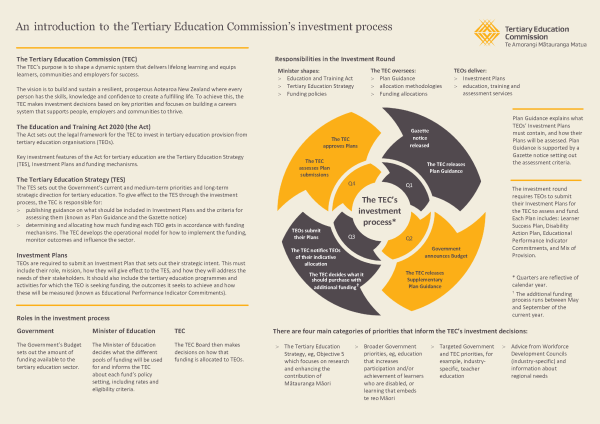Introduction to the TEC’s investment process
He kupu whakataki mō tā TEC tukanga haumi
This page describes TEC’s investment process, as well as who’s responsible for each part of the process and what the different stakeholders in the system do.
This page describes TEC’s investment process, as well as who’s responsible for each part of the process and what the different stakeholders in the system do.
Download a PDF version of Introduction to the TEC's investment process (PDF 357 KB)
The Tertiary Education Commission (TEC)
The TEC’s purpose is to shape a dynamic system that delivers lifelong learning and equips learners, communities and employers for success.
The vision is to build and sustain a resilient, prosperous Aotearoa New Zealand where every person has the skills, knowledge and confidence to create a fulfilling life. To achieve this, the TEC makes investment decisions based on key priorities and focuses on building a careers system that supports people, employers and communities to thrive.
The Education and Training Act 2020 (the Act)
The Act sets out the legal framework for the TEC to invest in tertiary education provision from tertiary education organisations (TEOs).
Key investment features of the Act for tertiary education are the Tertiary Education Strategy (TES), Investment Plans and funding mechanisms.
The Tertiary Education Strategy (TES)
The TES sets out the Government’s current and medium-term priorities and long-term strategic direction for tertiary education. To give effect to the TES through the investment process, the TEC is responsible for:
- publishing guidance on what should be included in Investment Plans and the criteria forassessing them (known as Plan Guidance and the Gazette notice)
- determining and allocating which TEO gets how much funding in accordance with fundingmechanisms. The TEC develops the operational model for how to implement the funding,monitor outcomes and influence the sector.
Investment Plans
TEOs are required to submit an Investment Plan that sets out their strategic intent. This must include their role, mission, how they will give effect to the TES, and how they will address the needs of their stakeholders. It should also include the tertiary education programmes and activities for which the TEO is seeking funding, the outcomes it seeks to achieve and how these will be measured (known as Educational Performance Indicator Commitments).
Roles in the investment process
Government
The Government’s Budget sets out the amount of funding available to the tertiary education sector.
Minister of Education
The Minister of Education decides what the different pools of funding will be used for and informs the TEC about each fund’s policy setting, including rates and eligibility criteria.
TEC
The TEC Board then makes decisions on how that funding is allocated to TEOs.
Responsibilities in the Investment Round
The Minister shapes:
- Education and Training Act
- Tertiary Education Strategy
- Funding policies
The TEC oversees:
- Plan Guidance
- allocation methodologies
- funding allocations
TEOs deliver:
- Investment Plans
- education, training and assessment services
The TEC's investment process
Quarters are reflective of calendar year.
Quarter 1:
- Gazette notice released
- The TEC releases Plan Guidance
Quarter 2:
- Government announces Budget
- The TEC releases Supplementary Plan Guidance
Quarter 3:
- The TEC decides what it should purchase with additional funding. The additional funding process runs between May and September of the current year.
- The TEC notifies TEOs of their indicative allocation
- TEOs submit their Plans
Quarter 4:
- The TEC assesses Plan submissions
- The TEC approves Plans
Investment Plans
Plan Guidance explains what TEOs’ Investment Plans must contain, and how their Plans will be assessed. Plan Guidance is supported by a Gazette notice setting out the assessment criteria.
The investment round requires TEOs to submit their Investment Plans for the TEC to assess and fund. Each Plan includes: Learner Success Plan, Disability Action Plan, Educational Performance Indicator Commitments, and Mix of Provision.
Priorities
There are four main categories of priorities that inform the TEC’s investment decisions:
- The Tertiary Education Strategy, eg, Objective 5 which focuses on research and enhancing the contribution of Mātauranga Māori
- Broader Government priorities, eg, education that increases participation and/or achievement of learners who are disabled, or learning that embeds te reo Māori
- Targeted Government and TEC priorities, for example, industry-specific, teacher education
- Advice from Workforce Development Councils (industry-specific) and information about regional needs
